idea使用记录(搭建maven)
2016-12-06 17:33
239 查看
前言
早就听说idea是开发java最好的工具,前段时间学了mongoDB,刚好借这个机会试试用下idea+maven来搭建一个小demo连接mongoDB(主要是看到mongoDB的github里面的介绍添加驱动的方式是使用maven)idea的安装
idea的安装过程比较简单,这里推荐一个地址,里面可以找到idea的注册码http://idea.iteblog.com/
http://idea.qinxi1992.cn/
上面的两个地址可以用来破解idea(对于有钱的同学可以直接购买正版的idea)
maven的安装
上面安装idea成功之后就是maven的安装http://fluagen.blog.51cto.com/146595/40086/
安装可以参考上面的步骤
maven中setting.xml的配置
更改本地仓库
安装完maven之后会有~/.m2/repository文件夹生成,这个文件夹是本地仓库,网上下载的库文件会保存在这里,当然本地的仓库是可以更改的,更改的配置在setting.xml文件夹下面,在标签下面添加:
<localRepository>D:\maven\library</localRepository>
配置仓库的镜像
因为maven默认的远程仓库是在国外,所以速度慢的离谱,我们可以配置阿里云的镜像:<mirrors> <!-- mirror | Specifies a repository mirror site to use instead of a given repository. The repository that | this mirror serves has an ID that matches the mirrorOf element of this mirror. IDs are used | for inheritance and direct lookup purposes, and must be unique across the set of mirrors. | <mirror> <id>mirrorId</id> <mirrorOf>repositoryId</mirrorOf> <name>Human Readable Name for this Mirror.</name> <url>http://my.repository.com/repo/path</url> </mirror> --> <mirror> <id>nexus-aliyun</id> <mirrorOf>*</mirrorOf> <name>Nexus aliyun</name> <url>http://maven.aliyun.com/nexus/content/groups/public</url> </mirror> </mirrors>
最后放上我整个setting.xml文件的配置:
<?xml version="1.0" encoding="UTF-8"?> <!-- Licensed to the Apache Software Foundation (ASF) under one or more contributor license agreements. See the NOTICE file distributed with this work for additional information regarding copyright ownership. The ASF licenses this file to you under the Apache License, Version 2.0 (the "License"); you may not use this file except in compliance with the License. You may obtain a copy of the License at http://www.apache.org/licenses/LICENSE-2.0 Unless required by applicable law or agreed to in writing, software distributed under the License is distributed on an "AS IS" BASIS, WITHOUT WARRANTIES OR CONDITIONS OF ANY KIND, either express or implied. See the License for the specific language governing permissions and limitations under the License. --> <!-- | This is the configuration file for Maven. It can be specified at two levels: | | 1. User Level. This settings.xml file provides configuration for a single user, | and is normally provided in ${user.home}/.m2/settings.xml. | | NOTE: This location can be overridden with the CLI option: | | -s /path/to/user/settings.xml | | 2. Global Level. This settings.xml file provides configuration for all Maven | users on a machine (assuming they're all using the same Maven | installation). It's normally provided in | ${maven.home}/conf/settings.xml. | | NOTE: This location can be overridden with the CLI option: | | -gs /path/to/global/settings.xml | | The sections in this sample file are intended to give you a running start at | getting the most out of your Maven installation. Where appropriate, the default | values (values used when the setting is not specified) are provided. | |--> <settings xmlns="http://maven.apache.org/SETTINGS/1.0.0" xmlns:xsi="http://www.w3.org/2001/XMLSchema-instance" xsi:schemaLocation="http://maven.apache.org/SETTINGS/1.0.0 http://maven.apache.org/xsd/settings-1.0.0.xsd"> <!-- localRepository | The path to the local repository maven will use to store artifacts. | | Default: ~/.m2/repository <localRepository>/path/to/local/repo</localRepository> --> <!--指定本地仓库--> <localRepository>D:\maven\library</localRepository> <!-- interactiveMode | This will determine whether maven prompts you when it needs input. If set to false, | maven will use a sensible default value, perhaps based on some other setting, for | the parameter in question. | | Default: true <interactiveMode>true</interactiveMode> --> <!-- offline | Determines whether maven should attempt to connect to the network when executing a build. | This will have an effect on artifact downloads, artifact deployment, and others. | | Default: false <offline>false</offline> --> <!-- pluginGroups | This is a list of additional group identifiers that will be searched when resolving plugins by their prefix, i.e. | when invoking a command line like "mvn prefix:goal". Maven will automatically add the group identifiers | "org.apache.maven.plugins" and "org.codehaus.mojo" if these are not already contained in the list. |--> <pluginGroups> <!-- pluginGroup | Specifies a further group identifier to use for plugin lookup. <pluginGroup>com.your.plugins</pluginGroup> --> </pluginGroups> <!-- proxies | This is a list of proxies which can be used on this machine to connect to the network. | Unless otherwise specified (by system property or command-line switch), the first proxy | specification in this list marked as active will be used. |--> <proxies> <!-- proxy | Specification for one proxy, to be used in connecting to the network. | <proxy> <id>optional</id> <active>true</active> <protocol>http</protocol> <username>proxyuser</username> <password>proxypass</password> <host>proxy.host.net</host> <port>80</port> <nonProxyHosts>local.net|some.host.com</nonProxyHosts> </proxy> --> </proxies> <!-- servers | This is a list of authentication profiles, keyed by the server-id used within the system. | Authentication profiles can be used whenever maven must make a connection to a remote server. |--> <servers> <!-- server | Specifies the authentication information to use when connecting to a particular server, identified by | a unique name within the system (referred to by the 'id' attribute below). | | NOTE: You should either specify username/password OR privateKey/passphrase, since these pairings are | used together. | <server> <id>deploymentRepo</id> <username>repouser</username> <password>repopwd</password> </server> --> <!-- Another sample, using keys to authenticate. <server> <id>siteServer</id> <privateKey>/path/to/private/key</privateKey> <passphrase>optional; leave empty if not used.</passphrase> </server> --> </servers> <!-- mirrors | This is a list of mirrors to be used in downloading artifacts from remote repositories. | | It works like this: a POM may declare a repository to use in resolving certain artifacts. | However, this repository may have problems with heavy traffic at times, so people have mirrored | it to several places. | | That repository definition will have a unique id, so we can create a mirror reference for that | repository, to be used as an alternate download site. The mirror site will be the preferred | server for that repository. |--> <mirrors> <!-- mirror | Specifies a repository mirror site to use instead of a given repository. The repository that | this mirror serves has an ID that matches the mirrorOf element of this mirror. IDs are used | for inheritance and direct lookup purposes, and must be unique across the set of mirrors. | <mirror> <id>mirrorId</id> <mirrorOf>repositoryId</mirrorOf> <name>Human Readable Name for this Mirror.</name> <url>http://my.repository.com/repo/path</url> </mirror> --> <mirror> <id>nexus-aliyun</id> <mirrorOf>*</mirrorOf> <name>Nexus aliyun</name> <url>http://maven.aliyun.com/nexus/content/groups/public</url> </mirror> </mirrors> <!-- profiles | This is a list of profiles which can be activated in a variety of ways, and which can modify | the build process. Profiles provided in the settings.xml are intended to provide local machine- | specific paths and repository locations which allow the build to work in the local environment. | | For example, if you have an integration testing plugin - like cactus - that needs to know where | your Tomcat instance is installed, you can provide a variable here such that the variable is | dereferenced during the build process to configure the cactus plugin. | | As noted above, profiles can be activated in a variety of ways. One way - the activeProfiles | section of this document (settings.xml) - will be discussed later. Another way essentially | relies on the detection of a system property, either matching a particular value for the property, | or merely testing its existence. Profiles can also be activated by JDK version prefix, where a | value of '1.4' might activate a profile when the build is executed on a JDK version of '1.4.2_07'. | Finally, the list of active profiles can be specified directly from the command line. | | NOTE: For profiles defined in the settings.xml, you are restricted to specifying only artifact | repositories, plugin repositories, and free-form properties to be used as configuration | variables for plugins in the POM. | |--> <profiles> <!-- profile | Specifies a set of introductions to the build process, to be activated using one or more of the | mechanisms described above. For inheritance purposes, and to activate profiles via <activatedProfiles/> | or the command line, profiles have to have an ID that is unique. | | An encouraged best practice for profile identification is to use a consistent naming convention | for profiles, such as 'env-dev', 'env-test', 'env-production', 'user-jdcasey', 'user-brett', etc. | This will make it more intuitive to understand what the set of introduced profiles is attempting | to accomplish, particularly when you only have a list of profile id's for debug. | | This profile example uses the JDK version to trigger activation, and provides a JDK-specific repo. <profile> <id>jdk-1.4</id> <activation> <jdk>1.4</jdk> </activation> <repositories> <repository> <id>jdk14</id> <name>Repository for JDK 1.4 builds</name> <url>http://www.myhost.com/maven/jdk14</url> <layout>default</layout> <snapshotPolicy>always</snapshotPolicy> </repository> </repositories> </profile> --> <!-- | Here is another profile, activated by the system property 'target-env' with a value of 'dev', | which provides a specific path to the Tomcat instance. To use this, your plugin configuration | might hypothetically look like: | | ... | <plugin> | <groupId>org.myco.myplugins</groupId> | <artifactId>myplugin</artifactId> | | <configuration> | <tomcatLocation>${tomcatPath}</tomcatLocation> | </configuration> | </plugin> | ... | | NOTE: If you just wanted to inject this configuration whenever someone set 'target-env' to | anything, you could just leave off the <value/> inside the activation-property. | <profile> <id>env-dev</id> <activation> <property> <name>target-env</name> <value>dev</value> </property> </activation> <properties> <tomcatPath>/path/to/tomcat/instance</tomcatPath> </properties> </profile> --> </profiles> <!-- activeProfiles | List of profiles that are active for all builds. | <activeProfiles> <activeProfile>alwaysActiveProfile</activeProfile> <activeProfile>anotherAlwaysActiveProfile</activeProfile> </activeProfiles> --> </settings>
接下在idea里面配置maven:
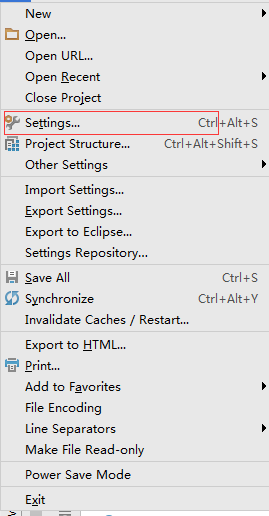
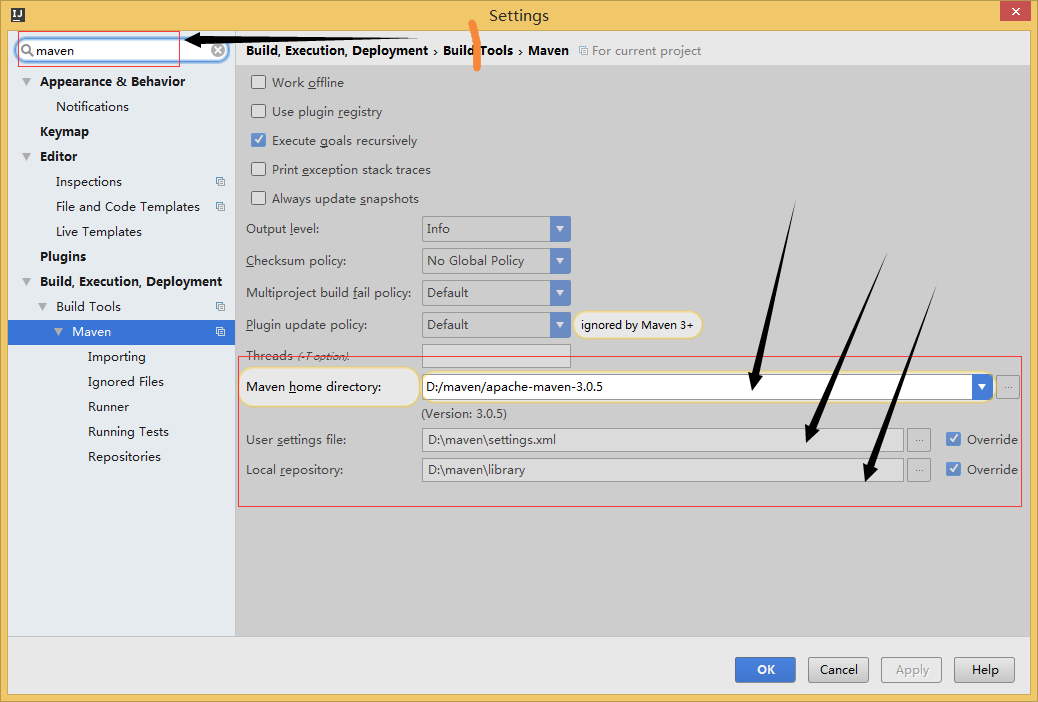
按照上面的步骤配置maven,其中
d:\maven\library是我指定的本地仓库,
User settings file这个里面是我将maven的安装目录里面的
conf\setting.xml这个文件复制到仓库里面的,例如我的maven是安装在d:\maven\apache-maven-3.0.5,那么我的配置文件就是在d:\maven\apache-maven-3.0.5\conf\setting.xml,我将这个文件复制到我指定的本地仓库里面去了
使用idea基于maven构建web项目
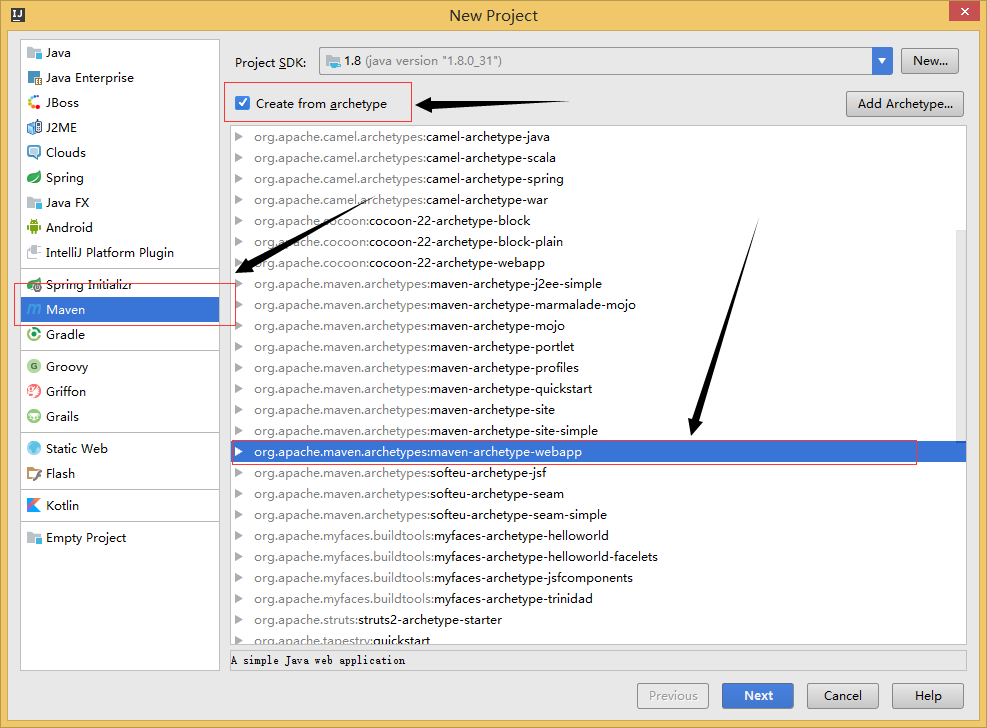
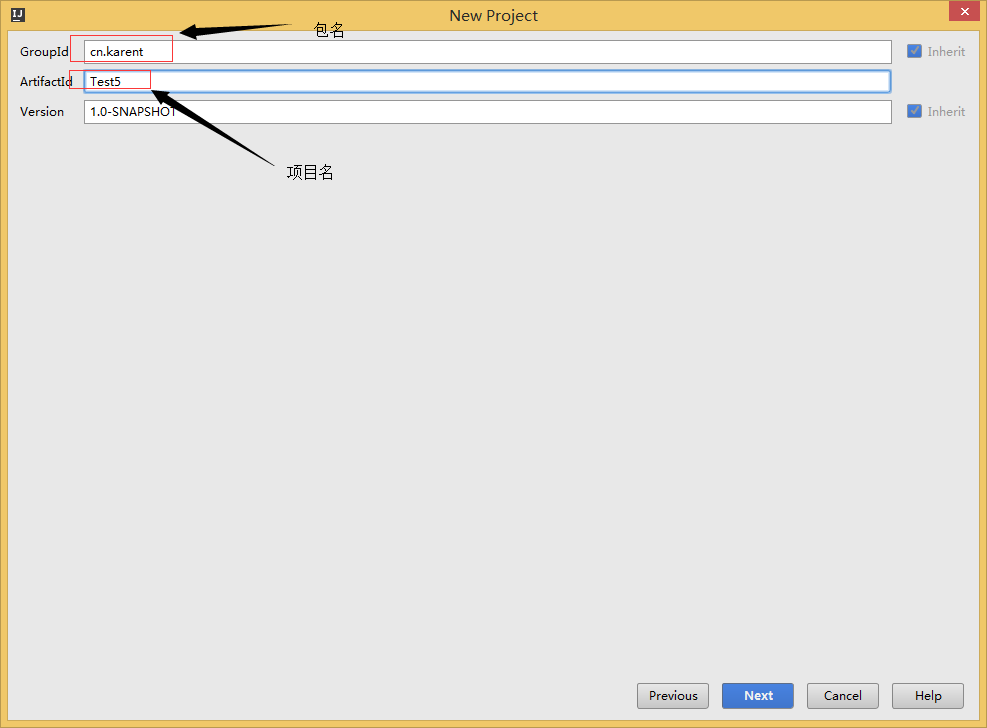
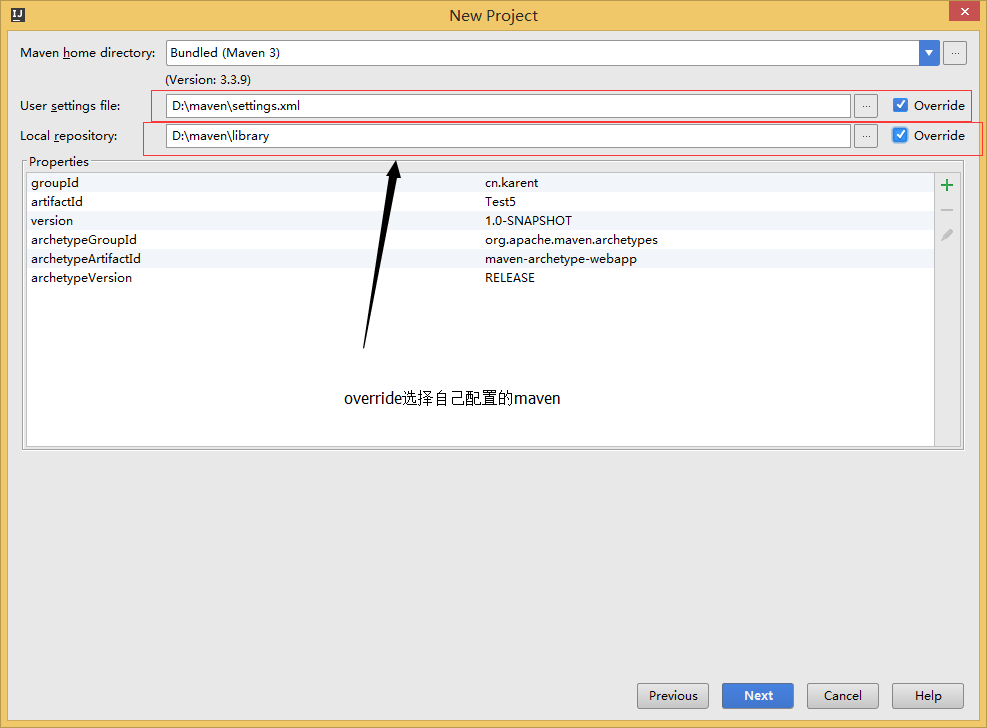
然后点击finish,就等idea自动构建完成了
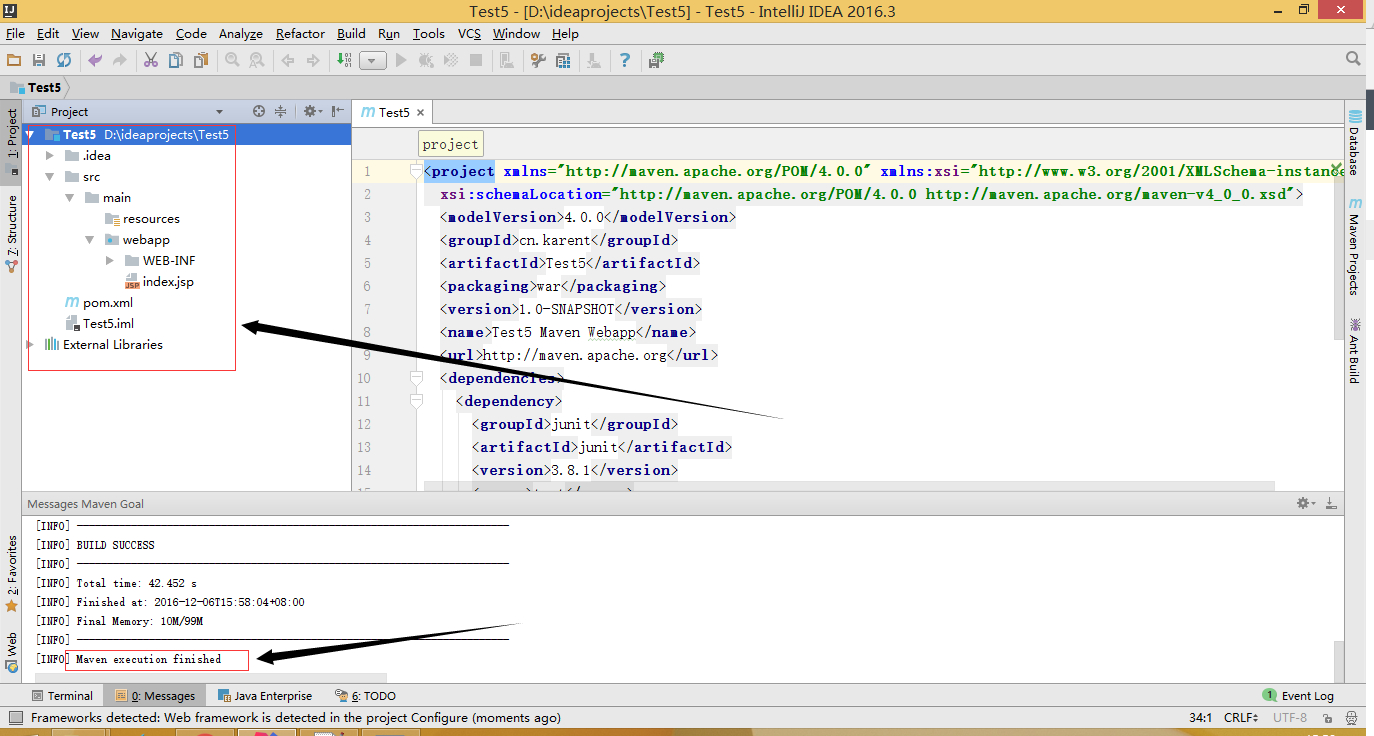
构建完成就会出现底部的提示和左边的目录树
接下来添加web开发和mongoDB需要的依赖,打开左边目录树里面的pom.xml文件,然后找到
<dependencies></dependencies>,在里面添加如下所示的依赖:
<dependency> <groupId>org.mongodb</groupId> <artifactId>mongo-java-driver</artifactId> <version>3.2.0</version> </dependency> <!--servlet依赖--> <dependency> <groupId>javax.servlet</groupId> <artifactId>javax.servlet-api</artifactId> <version>3.0.1</version> <scope>provided</scope> </dependency>
先配置一下tomcat吧
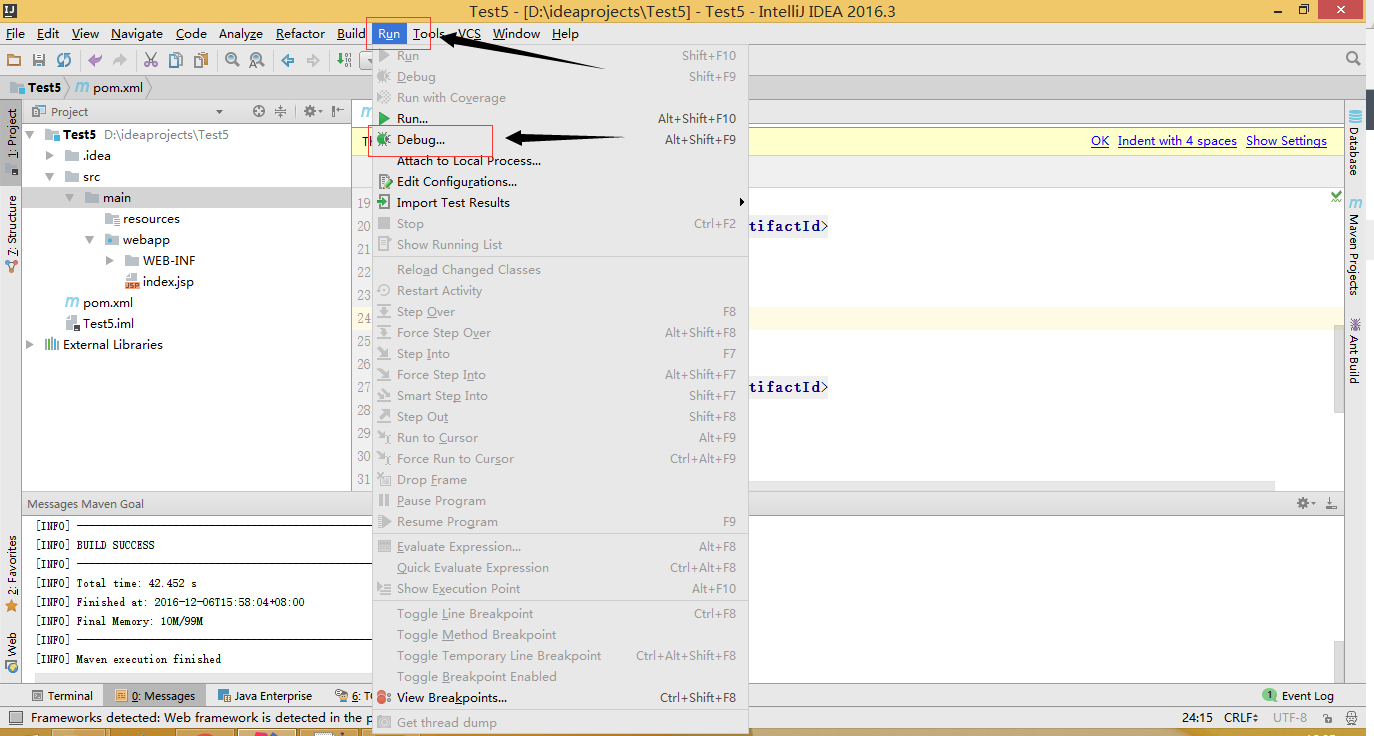
点击debug会出来一个dialog
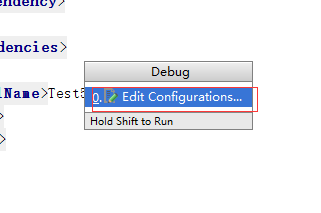
下来还是直接上动图吧

java连接mongoDB
因为上面创建的工程师没有java源文件的,需要自己创建源文件:
然后将自己创建的java文件夹指定为source文件夹:

然后新建一个包和类,建好之后的目录树如下:

在里面加入如下所示代码:
package cn.karent.servlet;
import com.mongodb.DB;
import com.mongodb.MongoClient;
import javax.servlet.http.HttpServlet;
import javax.servlet.http.HttpServletRequest;
import javax.servlet.http.HttpServletResponse;
import java.io.PrintWriter;
import java.util.Set;
/**
* Created by wan on 2016/12/6.
*/
public class Hello extends HttpServlet {
private MongoClient mongoClient = new MongoClient("localhost", 27017);
public void doGet(HttpServletRequest req, HttpServletResponse resp) {
DB db = mongoClient.getDB("test");
Set<String> colls = db.getCollectionNames();
try {
PrintWriter out = resp.getWriter();
for(String s : colls) {
out.println("collection:" + s);
}
} catch (Exception e) {
e.printStackTrace();
}
}
}web.xml配置如下:
<!DOCTYPE web-app PUBLIC "-//Sun Microsystems, Inc.//DTD Web Application 2.3//EN" "http://java.sun.com/dtd/web-app_2_3.dtd" > <web-app> <display-name>Archetype Created Web Application</display-name> <servlet> <servlet-name>hello</servlet-name> <servlet-class>cn.karent.servlet.Hello</servlet-class> </servlet> <servlet-mapping> <servlet-name>hello</servlet-name> <url-pattern>/hello</url-pattern> </servlet-mapping> </web-app>
结果
浏览器:
mongo客户端

相关文章推荐
- 记录:使用IDEA搭建Maven+SSM的过程
- Maven项目管理(一) IntelliJ Idea+Maven环境搭建与基于命令行的基本使用
- Idea使用Maven创建多模块SpringBoot项目问题记录
- Idea开发环境中搭建Maven并且使用Maven打包部署程序
- 使用IDEA搭建Maven+SpringMVC+Spring+Hibernate环境
- Adam学习22之在window下使用idea的maven编译安装记录
- IDEA使用maven搭建java项目连接redis(图文)
- idea使用maven创建WebApp项目+项目搭建
- SSH整合案例------使用idea maven搭建 注解版
- 使用nexus在局域网内搭建maven私服及idea的使用
- Idea开发环境中搭建Maven并且使用Maven打包部署程序
- IDEA使用Maven搭建SSM项目
- 使用IDEA Maven搭建mybatis环境
- 使用Lift+Maven+Idea搭建web应用
- Idea开发环境中搭建Maven并且使用Maven打包部署程序
- 使用idea搭建一个简单的SSM框架:(1)使用idea创建maven项目
- 使用nexus在局域网内搭建maven私服及idea的使用
- 初识hibernate,使用idea maven项目搭建
- 使用IDEA搭建SSM框架(IDEA+Maven+Spring+SpringMVC+MyBatis)
